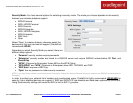
CRADLEPOINT MBR1400| USER MANUAL Firmware ver. 3.4.1
© 2012 CRADLEPOINT, INC. PLEASE VISIT HTTP://KNOWLEDGEBASE.CRADLEPOINT.COM/ FOR MORE HELP AND RESOURCES PAGE 88
TX Power: Normally the wireless transmitter operates at 100% power. In some circumstances, however, there might be a
need to isolate specific frequencies to a smaller area. By reducing the power of the radio, you can prevent transmissions
from reaching beyond your corporate/home office or designated wireless area.
RTS Threshold: When an excessive number of wireless packet collisions are occurring, wireless performance can be
improved by using the RTS/CTS (Request to Send/Clear to Send) handshake protocol. The wireless transmitter will begin
to send RTS frames (and wait for CTS) when data frame size in bytes is greater than the RTS Threshold. This setting
should remain at its default value.
Fragmentation Threshold: Wireless frames can be divided into smaller units (fragments) to improve performance in the
presence of RF interference and at the limits of RF coverage. Fragmentation will occur when frame size in bytes is greater
than the Fragmentation Threshold. This setting should remain at its default value. Setting the Fragmentation value too low
may result in poor performance.
DTIM: A DTIM is a countdown informing clients of the next window for listening to broadcast and multicast messages.
When the wireless router has buffered broadcast or multicast messages for associated clients, it sends the next DTIM
with a DTIM Interval value. Wireless clients detect the beacons and awaken to receive the broadcast and multicast
messages. The default value is 1. Valid settings are between 1 and 255.
Beacon: Beacons are packets sent by a wireless router to synchronize wireless devices. Specify a Beacon Period value
between 20 and 1000 milliseconds.
WPS: WiFi Protected Setup is a method for easy and secure establishment of a wireless network. It can be used instead
of passwords when connecting clients that support WPS.
Short Slot: Slot Time is the period wireless clients use in determining if the channel is free for transmission. Enabling this
value allows clients that can utilize a shorter time to do so. Disabling this option forces all clients to use a longer backoff
check and thus may reduce network throughput while reducing the number of transmission collisions.


















